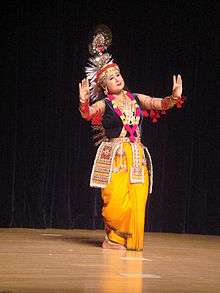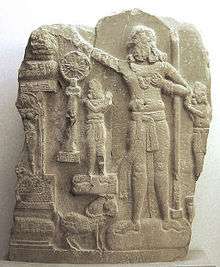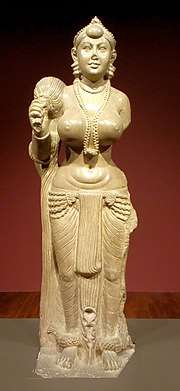Dhoti
The dhoti, also known as panche, vesti, dhuti, mardani, chaadra, dhotar or panchey, is a type of sarong that outwardly resembles trousers. It is a lower garment forming part of the national or ethnic costume for men in the Indian subcontinent.[1] The dhoti is fashioned out of a rectangular piece of unstitched cloth, usually around 4.5 metres (15 ft) long, wrapped around the waist and the legs and knotted either in the front or the back. Dhotis come in plain or solid colours, silk dhotis with embroidered borders are considered to be formal wear, these are worn to religious ceremonies and on national/ ethnic festivals. In contrast to dhotis, multi-coloured and patterned skirt-like sarongs called longyis (lungis) are worn at home and to casual errands and outings.[2] However there are exceptions to this rule in some South Indian communities where a plain white longyi (mundu) with embroidery is the ethnic formal wear for men.
Etymology
The word dhoti is derived from dhauti (Sanskrit: धौती), meaning to "cleanse or wash".[3] In the context of clothing, it simply refers to the cleansed garment which was worn as part of everyday attire[4]:129 The dhoti evolved from the ancient antriya which was passed through the legs, tucked at the back and covered the legs loosely, then flowed into long pleats at front of the legs, the same way it is worn today.[4]:130
Names in India

The garment is known by various names, such as:
| Language or region | ||
|---|---|---|
| धोती | Dhotī | Sanskrit, Pali |
| धोती | Dhotī | Hindi |
| मर्दानी | Mardaani | Hindi |
| ਚਾਦਰਾ | Chaadra | Punjabi |
| ଧୋତି | Dhotī | Odia |
| ધૉતિયુ | Dhotiyu | Gujarati |
| धोतर | Dhotar a | Marathi |
| চুৰিয়া, ধুতি | Suriya Dhuti | Assamese |
| ধুতি | Dhuti | Bengali |
| ಧೋತ್ರ ಕಚ್ಚ ಪಂಚೆ | Dhotra Kachcha Panche | Kannada |
| धोतर, आंगोस्तर, आड नेसचे, पुडवे | Dhotar Angostar Aad-neschey Pudve | Konkani |
| పంచ | Panchā | Telugu |
| ధోవతి | Dhovathi | Telugu |
| வேட்டி | Vaetti | Tamil |
| മുണ്ട് | Mundu | Malayalam |
| دھوتی | Dhoti | Urdu |
a In Marathi, a dhotar is not the same as a pancha (plural panche). While the former is worn around the waist, the latter is normally used as a towel after a bath or shower (compare below). | ||
Custom and usage
Dhoti is usually worn over a kaupinam or langot, types of loincloth undergarments.


The pancha is worn by many orthodox Jain men when they visit the temple for puja; unstitched clothing is believed by some Jains to be "less permeable to pollution" and therefore more appropriate for religious rituals than other garments.[5] They also wear a loose, unstitched cloth, shorter than the pancha, on top.
Hare Krishna, known for its distinctive dress code, prompts Western adherents to wear pancha, usually of saffron or white cloth folded in a traditional style. Maharishi Mahesh Yogi was known for wearing a white silk dhoti.[6]
In India, there's a distinction between the lungi, a similar but smaller garment often worn by people at their home as it is more casual and comfortable than dhoti, and the more formal dhoti that is sometimes worn by politicians.[7]
See also
References
| Wikimedia Commons has media related to Dhoti. |
- https://www.indianmirror.com/culture/clothing/dhoti.html
- https://www.indianmirror.com/culture/clothing/dhoti.html
- http://spokensanskrit.de/index.php?script=HK&beginning=0+&tinput=dhoti&trans=Translate&direction=AU
- Govind Sadashiv Ghurye (1951) Indian Costume
- Cort, John E. (2001). Jains in the World: Religious Values and Ideology in India. Oxford University Press. p. 221. ISBN 9780195132342.
- Koppel, Lily (February 6, 2008). "Maharishi Mahesh Yogi, a Guide On the Beatles' Spiritual Path, Dies". New York Times. p. C.10.
- McLain, Sean (2014-07-23). "No Dhotis Please, We're Indian". Wall Street Journal. Retrieved 2017-11-03.